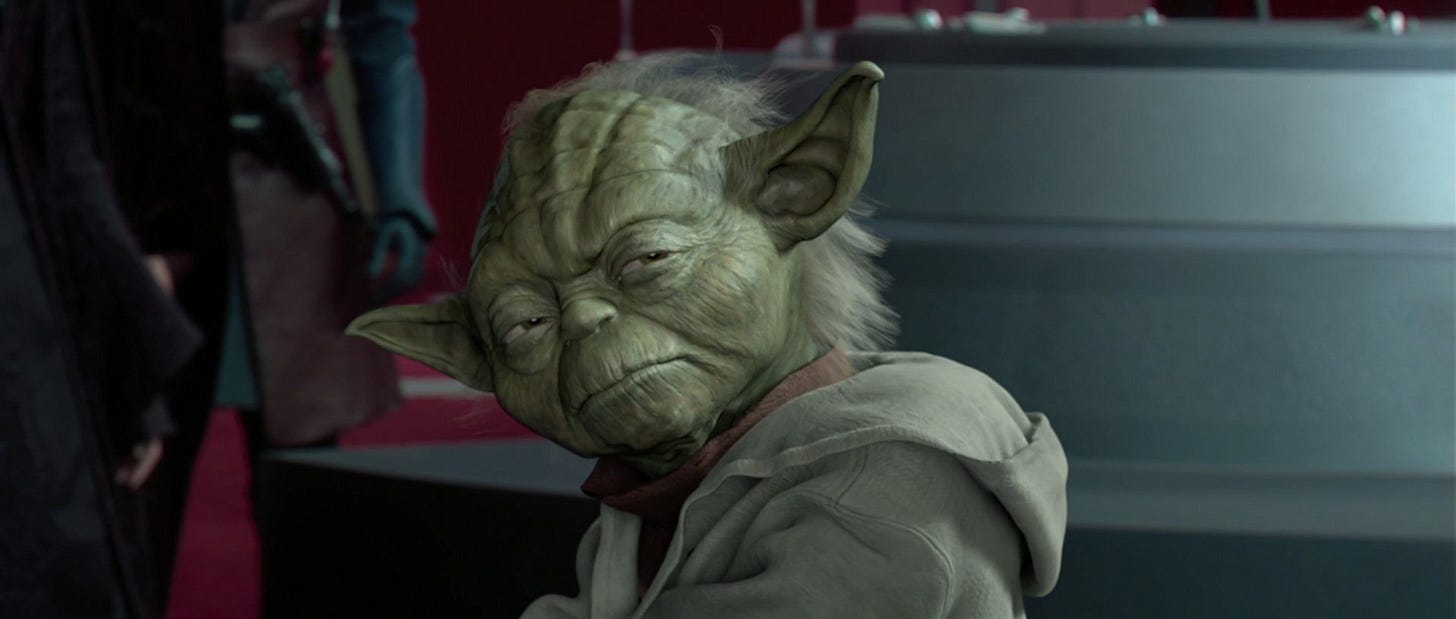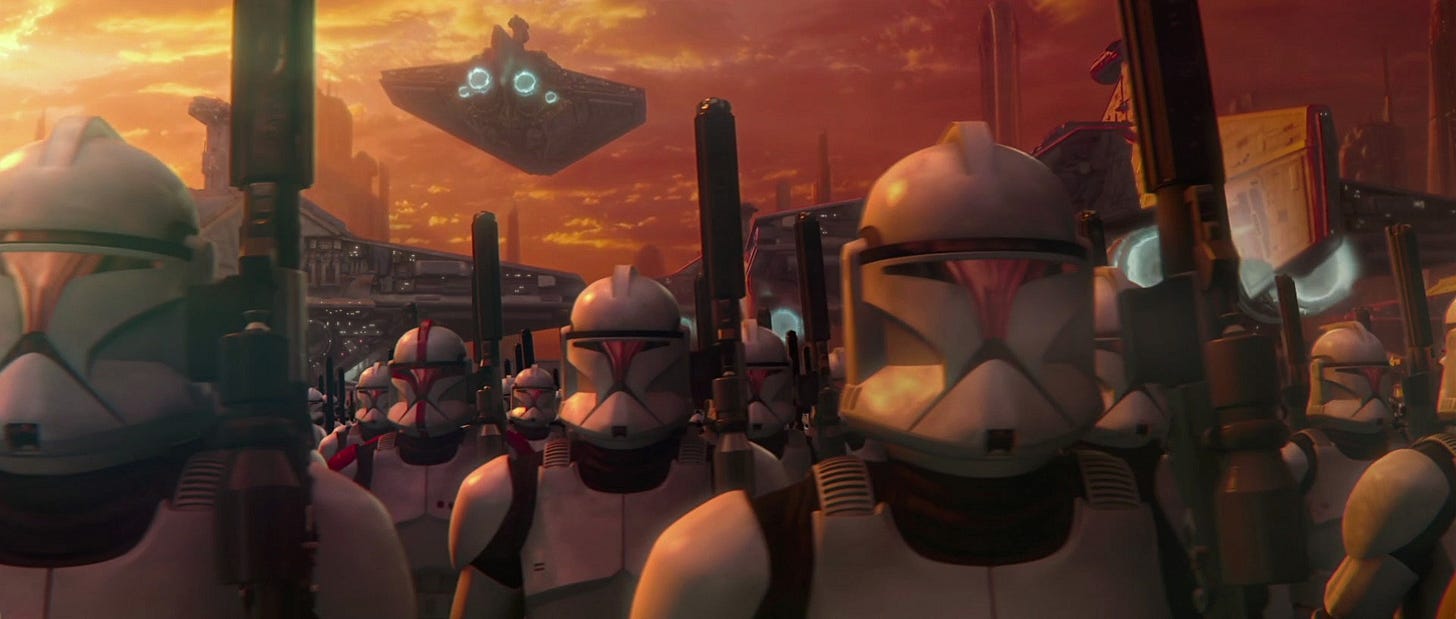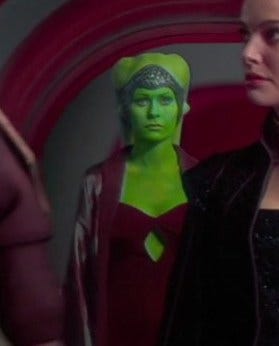Seventeen Years Since Attack of the Clones
After all this time, are we ready to like sand again?

After previously looking back on The Phantom Menace, now it’s time for what might be the strangest of all the Star Wars entries.
The clones fight on the same side as the Jedi.
Imagine it’s 1995 and I’m telling you about what’s coming in the Star Wars prequels. I say that the films will show the Clone Wars mentioned by Obi-Wan Kenobi offhand in A New Hope, complete with the Clone Army. Sounds about right, you think. Then I mention that the Stormtroopers from the original trilogy actually start off as these clones, that they represent the beginning of the military force of the Empire. Interesting, you might think. Then I add that Obi-Wan and Yoda fight on the same side as this proto-Empire military force of cloned slaves legally considered subhuman.
You might have some questions.

It’s an often observed criticism of the prequels, made text to an extent in 2017’s The Last Jedi, that the Jedi are too stupid to see what’s going on around them. Sheev Palpatine plays the Council like a fiddle, manipulating them into taking part in a fake war that only exists to strengthen his power, then uses the very army they led to wipe them out. They spend so much time sitting around and debating about meaningless rules that they’re oblivious to the collapse of democracy. This is usually used as a stick to beat George Lucas with, that he made his protagonists this stupid, but what if it was entirely intentional? The Jedi know that something is up in this film. Yoda responds to Palpatine’s suggestion for Obi-Wan and Anakin to protect Padme with a look of “I don’t trust this”. Everyone on the Council keeps talking about how the dark side has clouded their judgement, how there’s something fishy in the air but they can’t put their finger on it. But then when Count Dooku outright states what’s up, that the Sith lord Darth Sidious has control of the Senate, and the consensus among the Jedi is “nah, sounds like bullshit”. Instead, what they do is allow themselves to get sucked into a war where they know they aren’t really on the absolutely morally correct side (Jedi Master Ki-Adi-Mundi even calls Dooku a “political idealist” for his Separatist views early on), where there are some serious ethical issues about the force that is being used, essentially just because they officially work for the Republic.
What if all of this was entirely deliberate on the part of Lucas? As he’s been keen to point out, the original trilogy and especially Return of the Jedi is intended as commentary on the Vietnam War. While many interpreted the Rebel Alliance as the American revolutionaries against the British empire, Lucas suggests that the Empire is also America at a later stage in its evolution, when it has itself become the oppressive force. The subtext of the prequels, then, is showing how a just and noble society can collapse into an oppressive empire without anyone really noticing, how you get from standing up against the British in the name of liberty to dropping napalm bombs in Vietnam. As Marty McFly might say, this is heavy.
There is so much to pick at in terms of what this film is about. It’s such a shame, then, that it lets itself down in terms of how it is about those ideas.
The first thing you notice about Star Wars Episode II: Attack of the Clones is that it’s shot on digital rather than 35mm film. There are a lot of debates surrounding the pros and cons of digital vs celluloid, with many traditionalists insisting that you cannot create the same images with a digital camera while others argue this is merely backwards thinking. Someone like Steve Yedlin (director of photography on Star Wars: The Last Jedi among other things) goes so far as to argue that there is nothing stopping a modern digital camera from creating identical images to 35mm. This is now, though, while Clones was in 2002. Thus what we get is something that looks not unlike older British TV series shot on video tape. A very deliberate filmmaker can use “digitalness” to its advantage, but Lucas is always going for very straightforward camera work. He’s talked a lot about very directly recreating the techniques from the 30s and 40s serials he grew up with as well as World War 2 documentaries and other older sources, but what he fails to notice is that these things were specifically taking advantage of techniques to make celluloid look good. The Phantom Menace had a strange beauty to its visuals, but this is totally undercut by the move to digital on Clones.
Another strange visual choice it makes is in the colour correction. Lucas sees himself as a visual storyteller, and wants to indicate the themes of the film through bright colours. What he ends up with at times, though, is a ridiculous cartoonish look. Take this shot for example.

Now, look at the green woman at the back.

Now here’s what a character from the same alien species looks like in Return of the Jedi.

There’s a lot of bad CGI in Clones, but the digital photography and the ludicrous colour correction really make it stand out in garish ways. Not only does it totally clash with the presentation of the original trilogy, but it cuts against the very traditionalist methods Lucas says he is using here. The colours are toned down a bit in Revenge of the Sith, so it does seem that Lucas was aware he went to far this time. What it leaves us with is a very strange looking film.
Narratively, in some ways things are stronger than Menace. This time around, we have a clearly established protagonist and point of view character in Anakin Skywalker, while Obi-Wan functions straightforwardly as a second lead. The first act lays all the plot mechanisms out solidly enough, all greeted with that Lucas patented perfunctory dialogue and performances, but it does its job. The second act is where things get slightly strange. While the film had so far been a political intrigue thriller, it veers off into two wildly different directions. On the one hand, we have a neo-noir, in which hard boiled detective Obi-Wan Kenobi investigates the attack on Padme and uncovers a whole host of things involving a clone army for the Republic and Separatist plotting. Much of this is fairly ridiculous, but it all functions properly. Then on the other side we have, well, if you’ve ever made fun of this film, it’s probably because of Anakin’s scenes in act two. The romance with Padme has been picked apart so much, on so many levels, that there’s very little to add, but what really gets me is that the film never once bothers to see things from her perspective. No attempt is made to even gesture at why she suddenly falls so deeply in love with Anakin. It’s all shown from his angle and she just happens to fall for him, despite the obvious awfulness both intentional and unintentional. The other needle it just can’t seem to thread is how to tie Anakin’s feelings for Padme with his fear and then grief over his mother. He’s shown to be falling for Padme. He’s shown to have very terrifying dreams about his mother, then after watching her die he responds very poorly. What Lucas is never able to do is make these two points into one single character arc. Then, of course, the two plots come together for act three as we completely shift genres again to watch everything explode, and that’s the movie.

Lucas is very much playing with his ideas of rhyming and repetition here. The core structure here is reused from The Empire Strikes Back, but things are upside down (read the Star Wars Ring Theory for much, much more detail on this). The opening shot pans up to a planet, rather than down, to indicate this is the flipped structure. While Empire features a big ground battle with walker vehicles in its first act and spends its third in a cloud city, here we start in the, well, not clouds but smog of Coruscant and end with the proto-imperial vehicles in the Geonosis battle. Some of these scenes, such as Padme’s arrival on the landing platform, are so obviously calling back to their structural equivalent to make it plain that Lucas cares deeply about this stuff, and I’m barely even scratching the surface. He likely has very detailed charts in terms of how every moment in the prequels corresponds to something else in the Original Trilogy, and very complex ideas about how this emphasises his themes about the collapse of noble societies into vicious empires.
There’s an accusation often thrown at these films that Lucas cared only about showing off his technology and selling toys to kids, whereas once upon a time he wanted to tell a good story. I’ve always pushed back against this, but I’ve come to think that it’s correctly diagnosed the problem even as it totally misses the mark in terms of the cause. Lucas is very much interested in weighty ideas about how societies collapse in these films. He’s also drawing from ancient story structures and mythic ideas in terms of how he wants to express them. The ambition of what he’s trying to achieve might be unparalleled in terms of blockbuster filmmaking.
It’s here, though, where he makes his error. He becomes so engrossed in his grand ideas that he forgets that making a popular film is first and foremost about giving the audience a good time. In the recent criticism of Game of Thrones, a line used to beat showrunners David Benioff and D.B. Weiss with has been Benioff’s old quote, “themes are for eighth-grade book reports”. Doctor Who and Sherlock writer Steven Moffat has in the past gone even further than this, taking it so far as to call the whole idea of thematic storytelling a myth. “Nobody does themes”, Moffat said at a fan convention. “It’s a lie. Who have your heard say 'I’ve thought of a good theme?' They happen accidentally. You repeat yourself once too often and so it becomes a theme. We tell stories - that’s what people talk about, not themes.”
People very much dislike writers talking and these terms, and it’s hard to argue that Moffat’s work as well as Game of Thrones doesn’t suffer from a lack of things to say, from a desire to dazzle the audience more than engage with it. But the Star Wars prequels arguably offer a cautionary tale of going too far in the other direction. Lucas started with the ideas he wanted to get across, with the structure he wanted to follow, that he left himself seemingly unable to do the basic work of giving everyone a good time. Attack of the Clones has aspects of genuine merit, things that would be widely acclaimed as brilliant if they came in a better film. As it is, what we have is a fascinating misfire.



